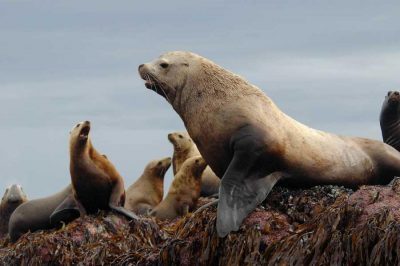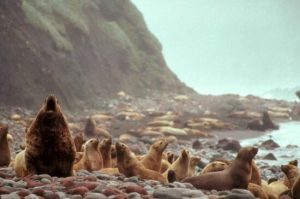Discovery and the Scientific Method (Week 2 of 2) – In Person
Scroll below for In-Person Labs

- Upload your Library Tutorial Assignment(opens in new window) to Moodle.
- Read Activity 1 Background (Appendix E, review pages 221-222 and read about data types, identifying variables and graphs, pp. 222-225).
- Upload the completed Initial Experimental Design Assignment form(opens in new window) to Moodle (see Lab 2 – week 1 for the EPD assignment description(opens in new window) ).
- Please bring a laptop or tablet to lab if possible. Each student will need computer access to complete the Peer Evaluation forms during Lab. There are 2 computer per table that can be used if needed.
Groups present their pill/sow bug graphs and discuss their experiments, ideas for revisions, challenges for designing experiments if there was not enough time last week in lab.
Activity One: Data Analysis – A Case Study of the Factors Contributing to the Decline of Steller Sea Lions (p. 16-17)
- Steller Sea Lion Research – Interpreting Graphs and Tables (p. 16)
- Read the Background on page 16.
- Each group will be provided with a different data table or graph(s) at your table OR assigned one of the figures in the link below to interpret.
- Steller sea lion graphs and tables
- As a group, answer questions 1 a, b, c, d in your lab manual for your assigned figure(s). Appendix E in your lab manual (or in the Resources webpage) pages 221-224 may be helpful.
- Be prepared to present your figure to the class.
- As a class we will discuss how these figures and different studies relate to one another and provide insight into the decline of Steller Sea Lions.
Initial Experimental Design Peer Review
- Initial Peer-Review form to use in class for the Initial Experimental Designs – Peer Review Criteria. Each student will share their Initial Experimental Design in a group google folder and ALSO verbally present their Initial Design to their group. Then provide time afterwards for discussion.
- Each of your peers will fill out this Peer-review form for your proposed experiment before moving along to the next student in the group. The Peer-review form is used to evaluate the design of each group member.
- Email a copy of each form you fill out to the appropriate presenter. Comments should be constructive (what is good, what needs work, what is unclear), are the variables appropriately designated? This way each group member will get a Peer-review form from EACH person in their group. That is a lot of helpful information!
- In addition to providing Peer-reviews for each other, you should copy and paste all the peer reviews you wrote and upload these into in Moodle for the Lab 2.2 In-Lab: Peer Review Experimental Design.
- You will also need to copy and paste ALL the Peer-reviews you receive to include them all at the end of the Final Experimental Designs that you will submit in Moodle 48 hours after lab. This way you keep all your feedback with your design plan.
Experimental Design Project Information – overview
- Design Project Description
- Experimental Design Timeline
- General Lab Report Rubric for Progress Report – focus on written Methods and Results that will be turned in for the Progress Report due later in the semester (see Lab Schedule)
- Final Presentation Structure
- Full Presentation Guide and Rubric (see Lab Schedule)
How to record your Presentation in Zoom and save to the cloud. For screen sharing and recording, you may need to unlock/enable permissions from your computer preferences menu (not zoom preferences). ALSO REMEMBER TO PROVIDE THE ZOOM PASSWORD with your Zoom link on your title slide.
Sample Scientific Papers
| Sample 1 -Mice(opens in new window) | Sample 2 -Rhinos(opens in new window) | Sample 3 -Iguana(opens in new window) | Sample 4 -Ecosystem(opens in new window) | Sample 5 -Parasites(opens in new window) |
Sample Scientific Papers – Primary vs. Secondary literature, pp. 17-18 – activity/discussion – review 5 Sample Scientific Papers as a class:
- Is your paper Primary and Secondary literature? How can you tell?
- How well did the paper follow Lab Report/Scientific literature structure? Did anything seem odd or different for you? Does this change your idea of Primary or Secondary Literature? Why or why not?
Oral Scientific Communications: Presentations – Use for your Experimental Design Final Presentation

- Appendix C: Making Presentations in your lab manual
- Organize information and PRACTICE before you present.
- Be professional in what you present (use visuals) AND in what you say.
- Your presentations should follow the same general format/sections of a scientific paper.
- Include primary literature references in your presentation.
- Be prepared to answer scientific questions related to your experimental design, results, etc.
